This post may contain affiliate links. Please read our disclosure policy.
These soft, homemade gluten free dinner rolls are easy enough for a weeknight—and special enough for any holiday table. They bake up golden, tender, and fluffy every time.
Why you’ll love these gluten free rolls:
- Soft, fluffy texture with a golden brown crust
- Quick 20-minute hands-on time with fast rise
- Dough is easy to handle—no stickiness or frustration
- Freezer-friendly for make-ahead convenience
- Simple to make dairy-free with easy swaps
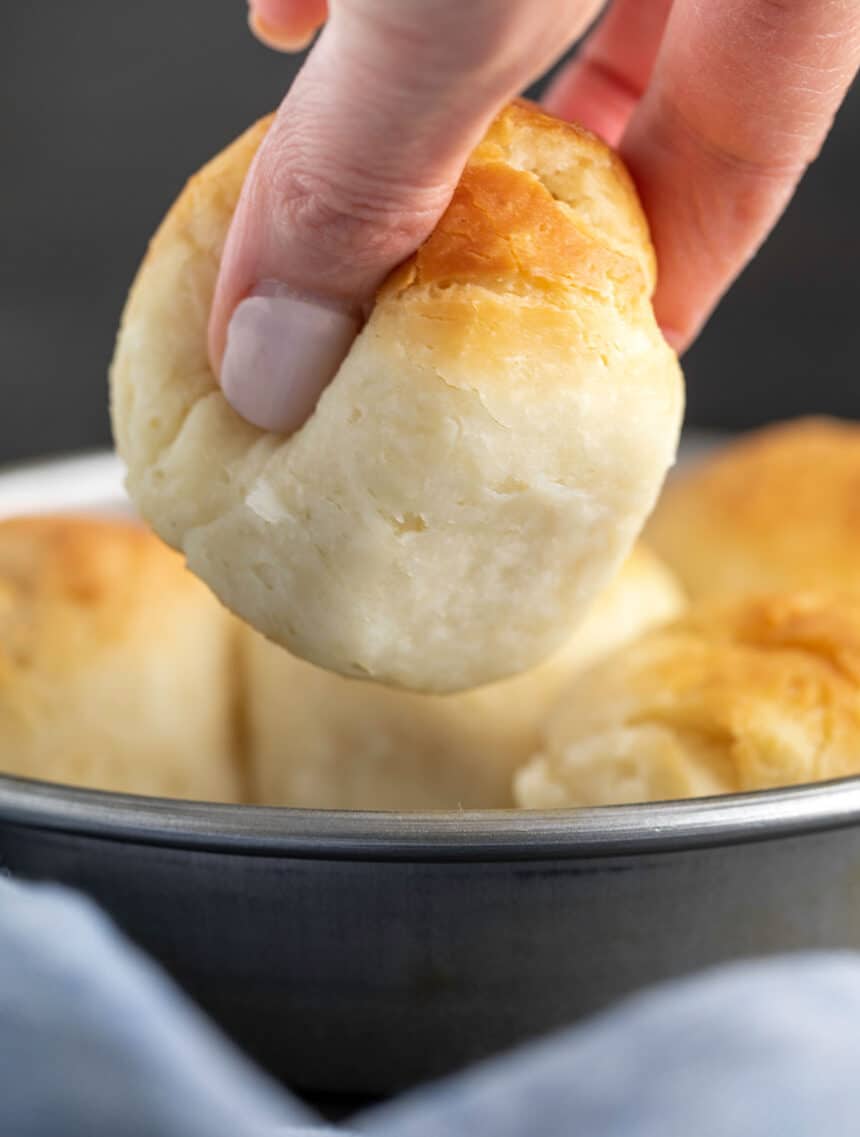
Recipe ingredients
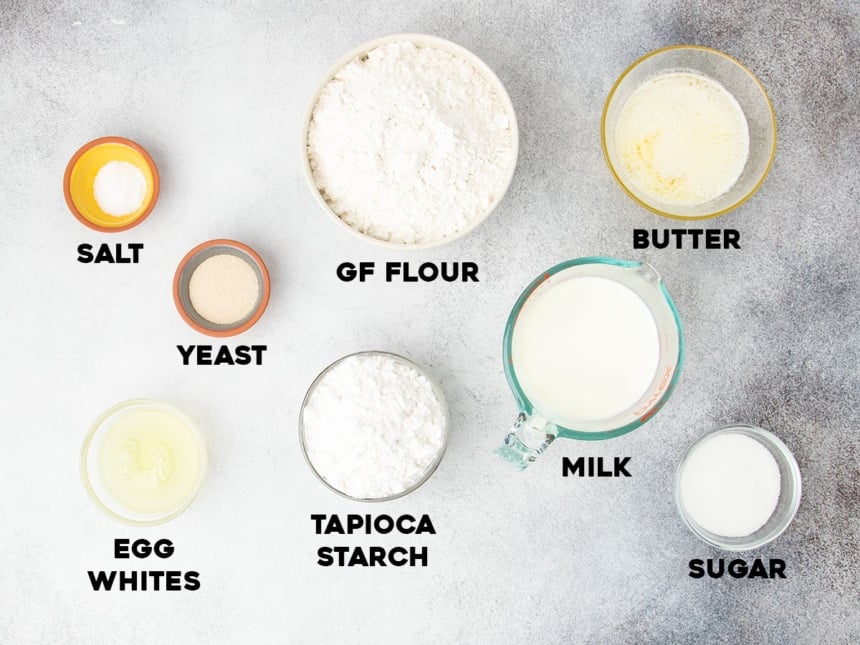
These few ingredients come together to make the softest, most tender gluten free rolls you’ve ever had:
- Gluten free flour – Use a high-quality all purpose gluten free flour blend made with finely ground rice flour. It should be designed for yeast baking.
- Tapioca starch – Even if your blend already includes some, this extra tapioca starch gives the dough stretch and flexibility.
- Instant yeast – Gives the rolls their rise. Also called rapid-rise or breadmaker yeast. Be sure yours is fresh.
- Sugar – Feeds the yeast and adds a subtle sweetness.
- Milk – Warm milk activates the yeast, moistens the dough, and adds richness.
- Butter – Adds moisture and flavor, keeping the rolls soft and tender.
- Egg whites – Provide structure and help bind the dough together.
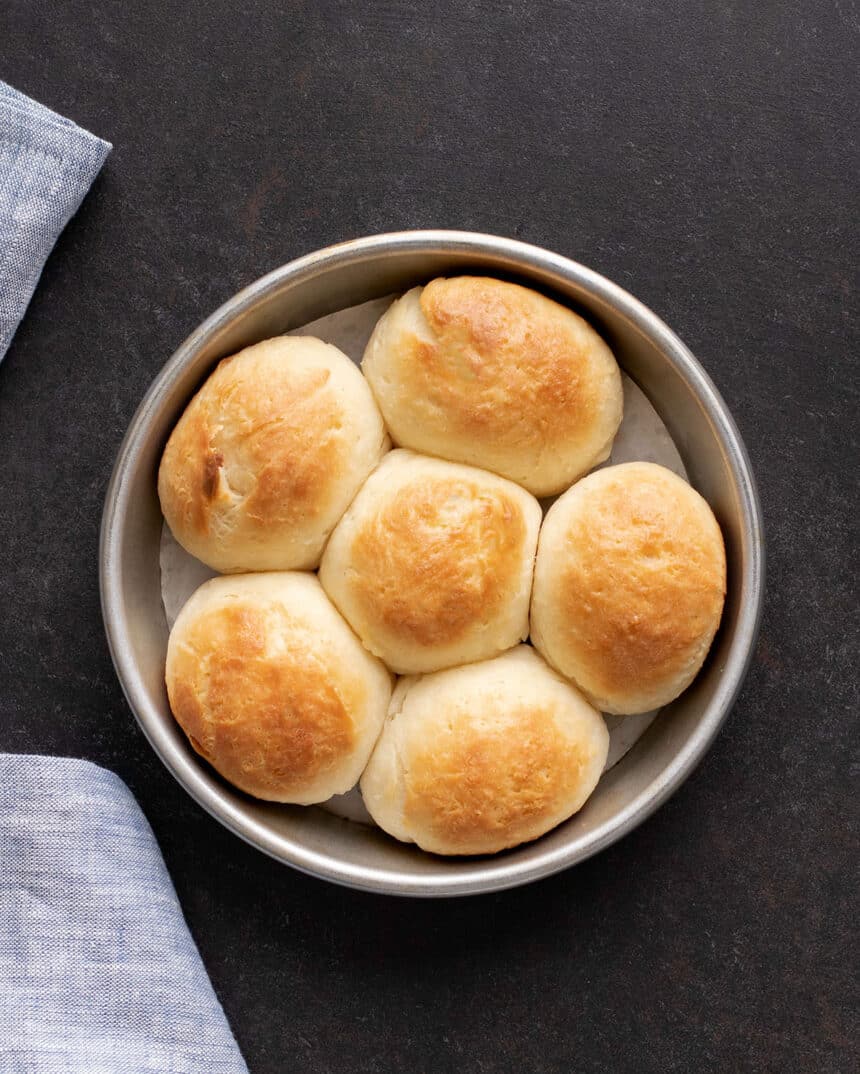
How to make soft gluten free dinner rolls
Step 1: Mix the dry ingredients
In the bowl of a stand mixer, if possible, whisk together the gluten free flour, xanthan gum (if needed), tapioca starch, yeast, and sugar until well combined. Whisk in salt next.
Step 2: Add wet ingredients and beat the dough
Pour in the warm milk, melted butter, and egg whites. Using the paddle attachment, beat the mixture until it comes together and begins to look whipped—about 6 minutes total.
Step 3: First rise
Transfer the dough to a lightly oiled container with a tight-fitting lid. Let it rest at room temperature for about 2 hours, or refrigerate it for up to 24 hours. If chilled, let the dough come back to room temperature before shaping.
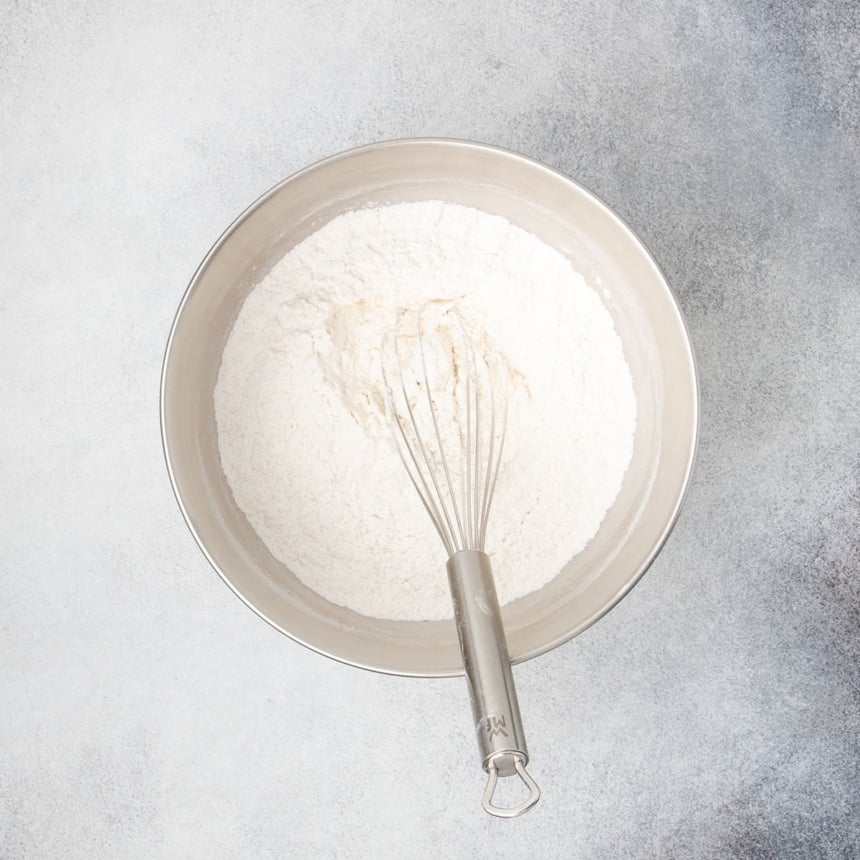
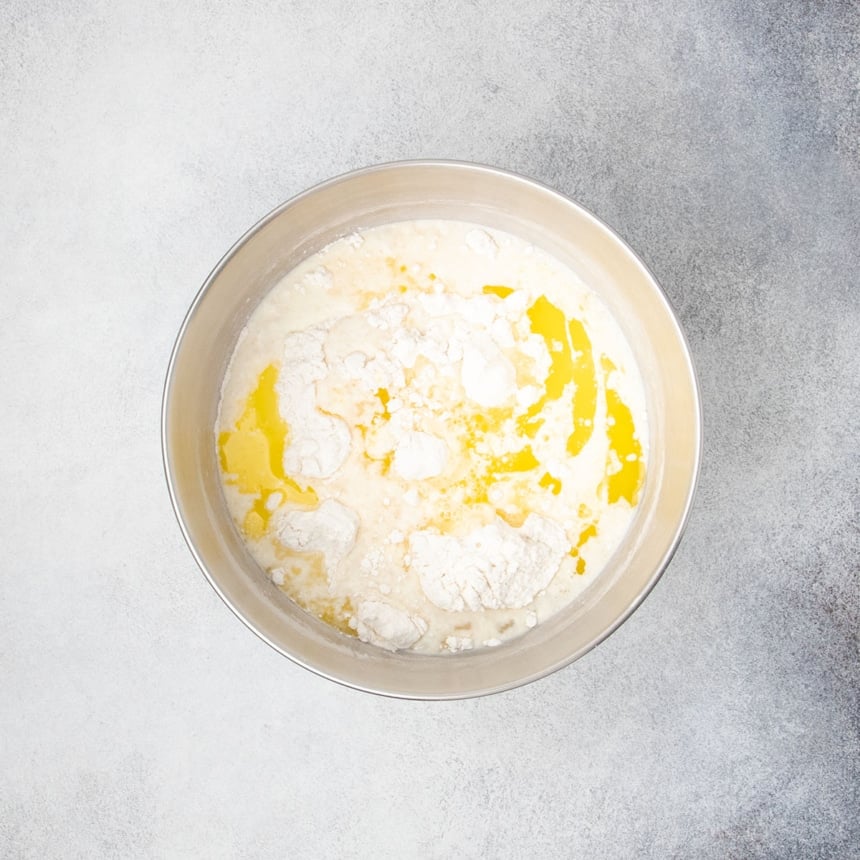
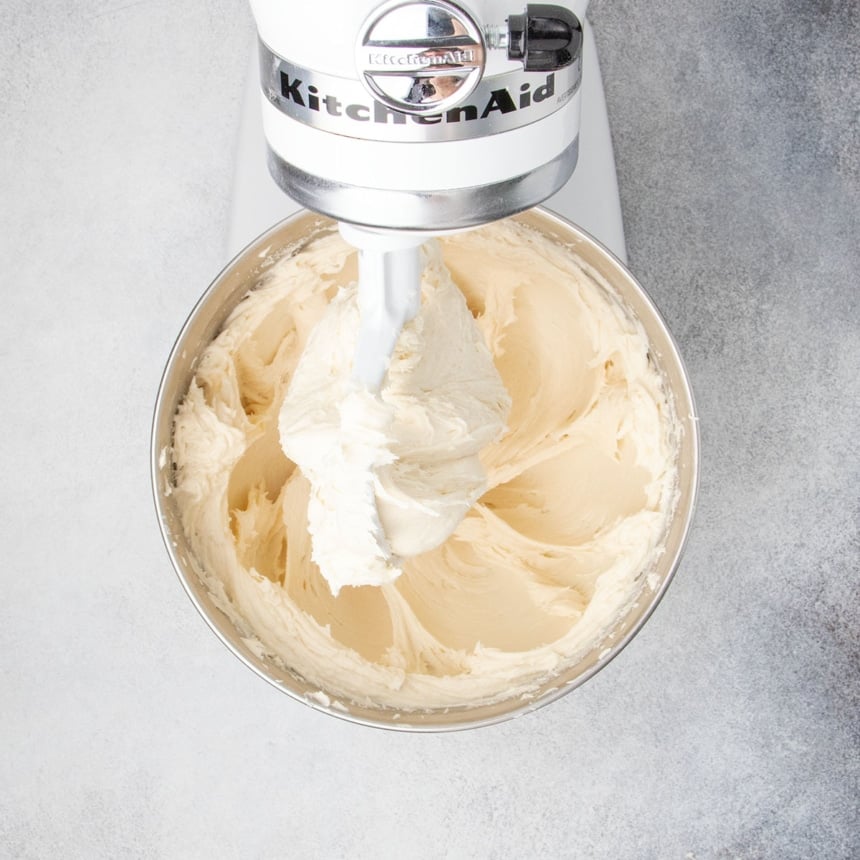
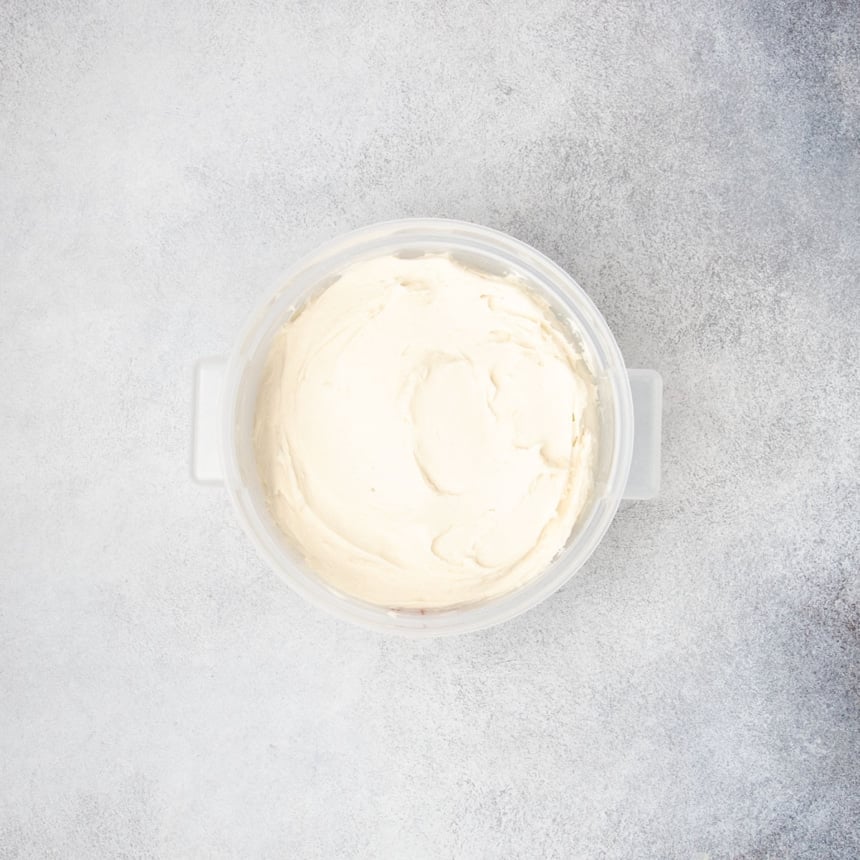
Step 4: Divide and shape
Turn the dough onto a very lightly floured surface and divide it in half, then each half into 8 equal pieces. Gently roll each piece into a ball by cupping your hand around the dough and moving it in a circular motion.
Step 5: Arrange and rise again
Place the rolls into a greased and lined baking pan. You can crowd them slightly for pull-apart rolls or leave space for individual ones. Cover with plastic wrap and let them rise in a warm, draft-free spot until at least 150% of their original size (they won't double).
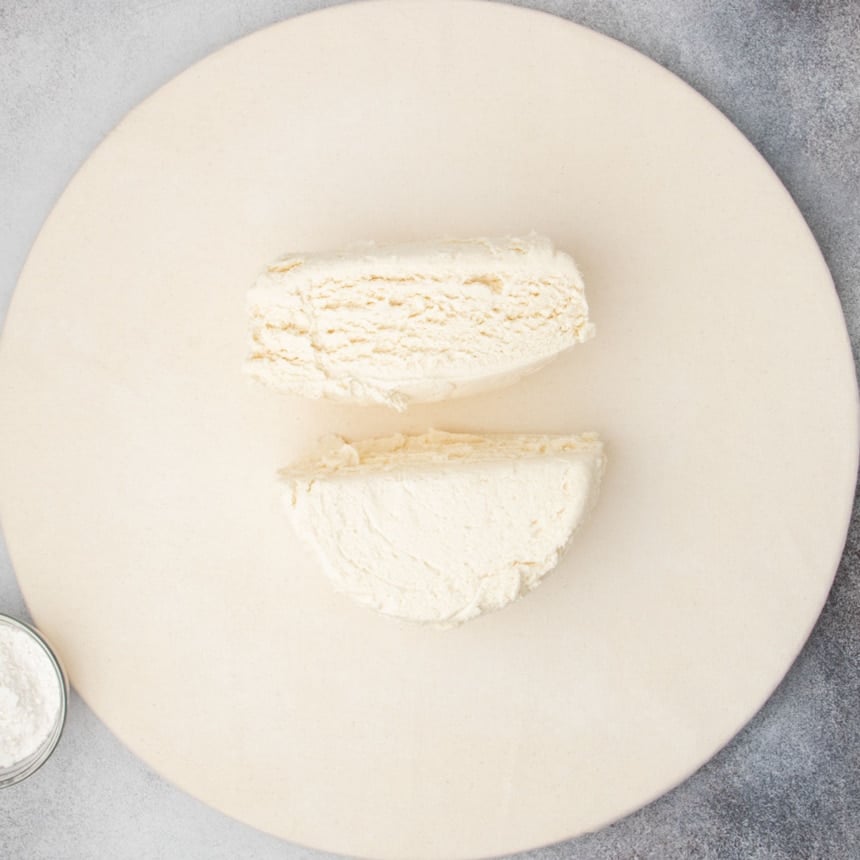

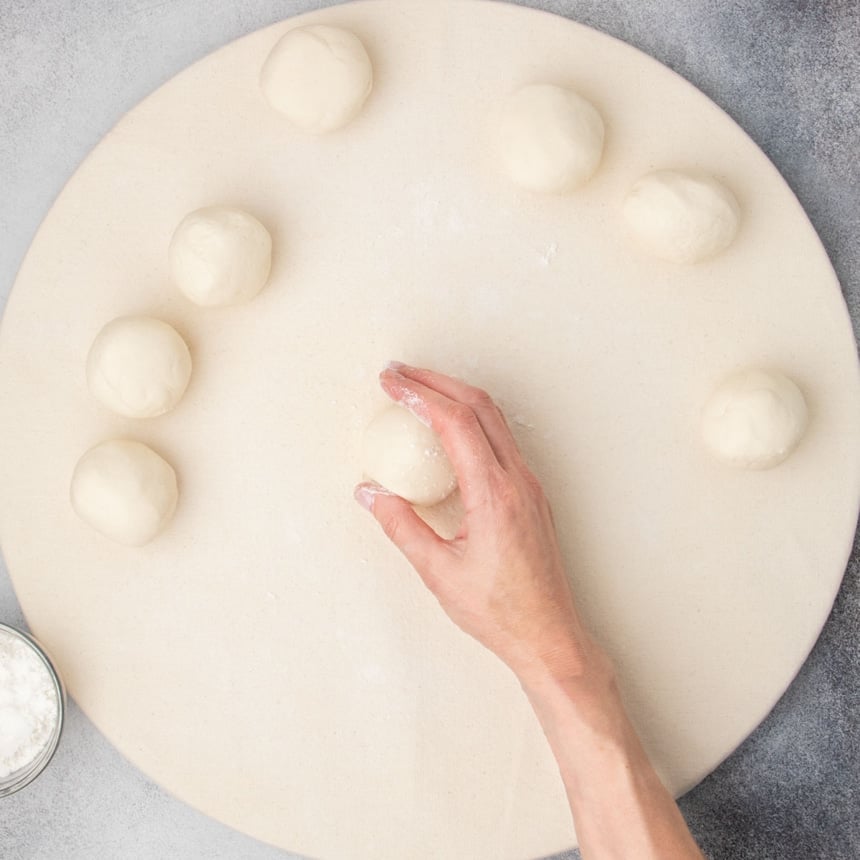
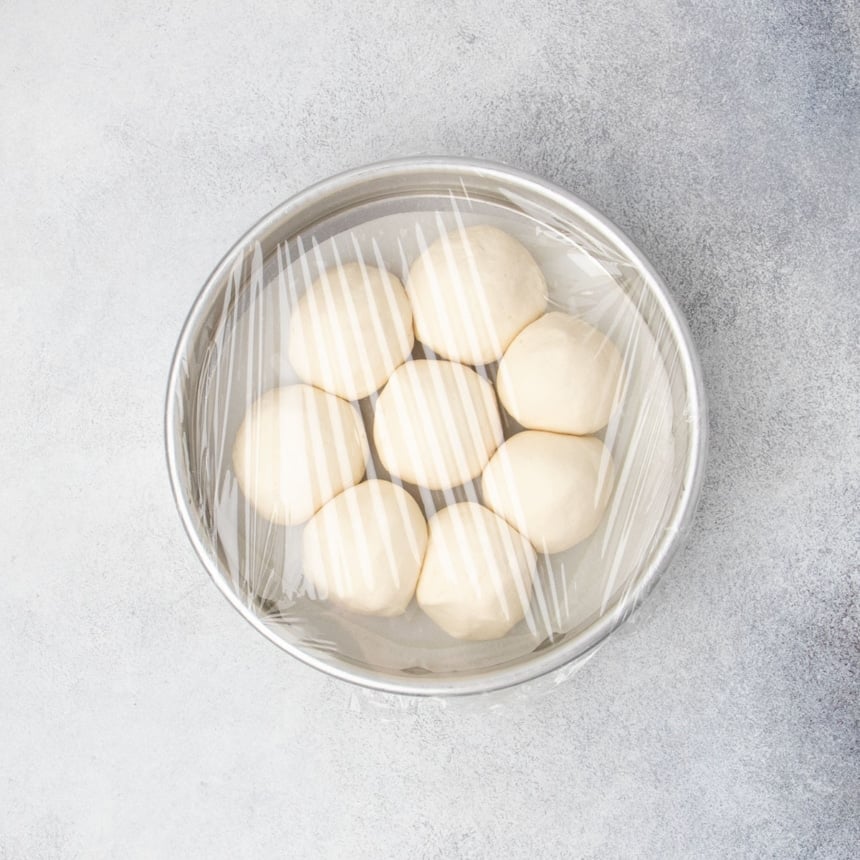
Step 6: Bake
Once risen, brush the tops with melted butter. Bake at 375°F until the rolls are golden and an instant-read thermometer reads around 190°F in the center—about 20 minutes. If the rolls are touching, reduce the oven temp to 350°F after 18 minutes and bake a bit longer.
Step 7: Serve warm
Brush the hot rolls with more melted butter, and serve while warm and soft.
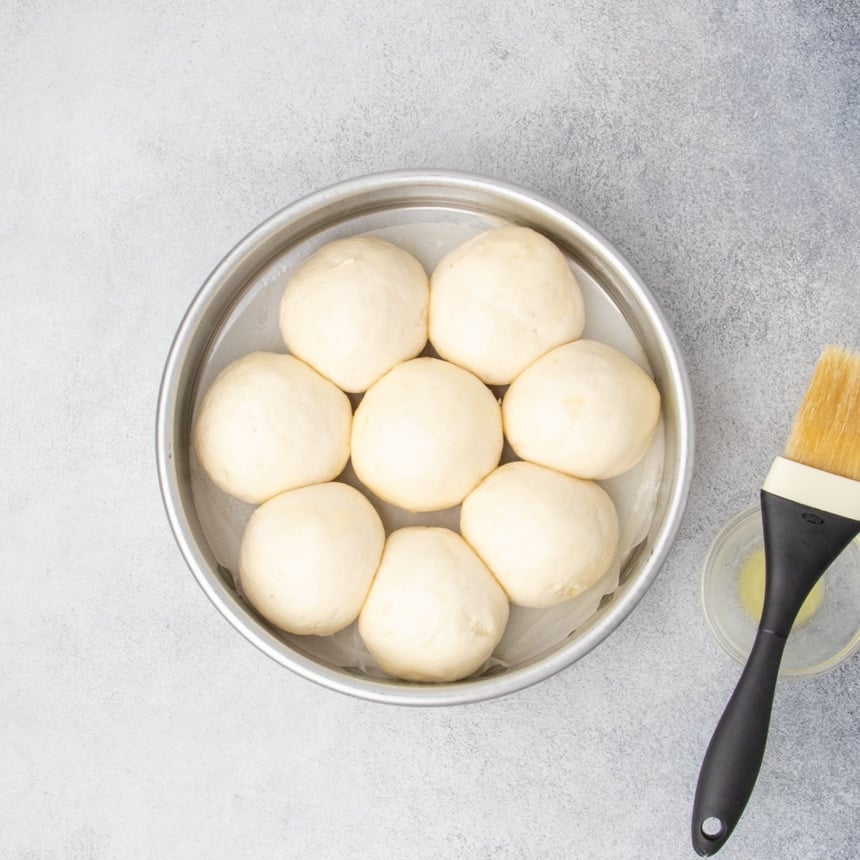
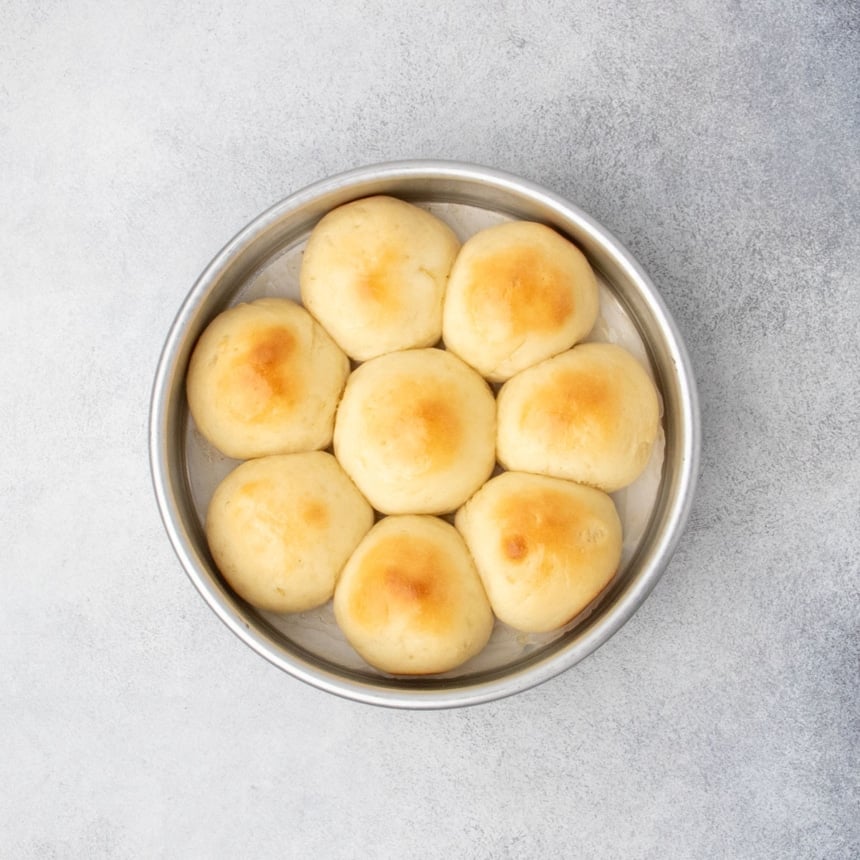
Expert tips for perfect rolls
Use a stand mixer if you can
A stand mixer with the paddle attachment creates the smooth, whipped dough that gives these rolls their signature texture. If needed, a food processor with a plastic blade can work—just pulse carefully and don’t overmix. Avoid hand mixing.
Create a warm, steady rise
Place your dough in a draft-free spot with gentle warmth—like on top of a warm oven, never inside. If the environment is too hot, you risk killing the yeast. Too cool, and the dough will rise very, very slowly. Too dry, and it won't rise.
Adjust for dry climates
If you live in a dry environment and your dough isn’t rising well, try adding 1 extra tablespoon of warm milk or water. But don’t overdo it—too much liquid can cause overproofing and gummy rolls.
Shape gently
Don’t press or knead the dough aggressively. On a lightly floured surface, cup your hand around the dough ball and gently move it in a tight circle on a very lightly floured surface to create a smooth round shape.
Want to make them ahead? Try parbaking
To prep rolls in advance, bake the shaped rolls at 300°F for about 15 minutes—just until puffed and set but not browned. Cool completely, then freeze. When ready to serve, defrost at room temp, then finish baking at 375°F until golden and fully cooked (190°F inside). This method gives you fresh-baked rolls in less time.
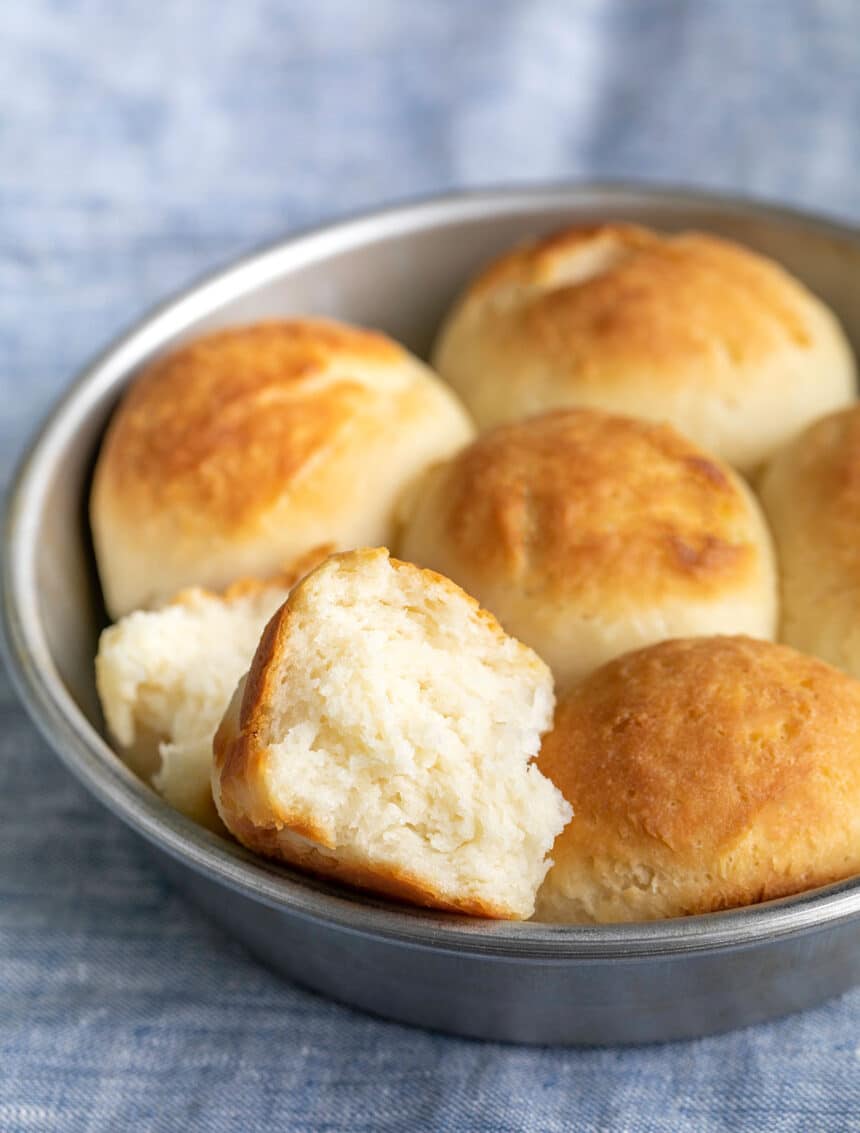
Easy ingredient swaps
Dairy free
Replace the melted butter with a block-style dairy-free butter alternative. Melt and Miyoko’s Kitchen brands both work well. For the milk, use an unsweetened nondairy variety with some fat and a texture that mimics cow's milk Avoid fat-free options, since richness matters here, and anything with unwanted texture, like oat milk.
Egg free
You should be able to replace the 2 egg whites with 50 grams of aquafaba (the liquid from a can of unsalted chickpeas).
Yeast
You can’t make these rolls without yeast, but you can swap instant yeast for active dry yeast. Use 15 grams of active dry yeast and be sure to proof it first in some of the warm milk.
Tapioca starch
Even though most good gluten free flour blends already include tapioca starch, this recipe needs extra. If you don’t have it, try replacing it with an equal amount of superfine glutinous rice flour or sweet white rice flour.
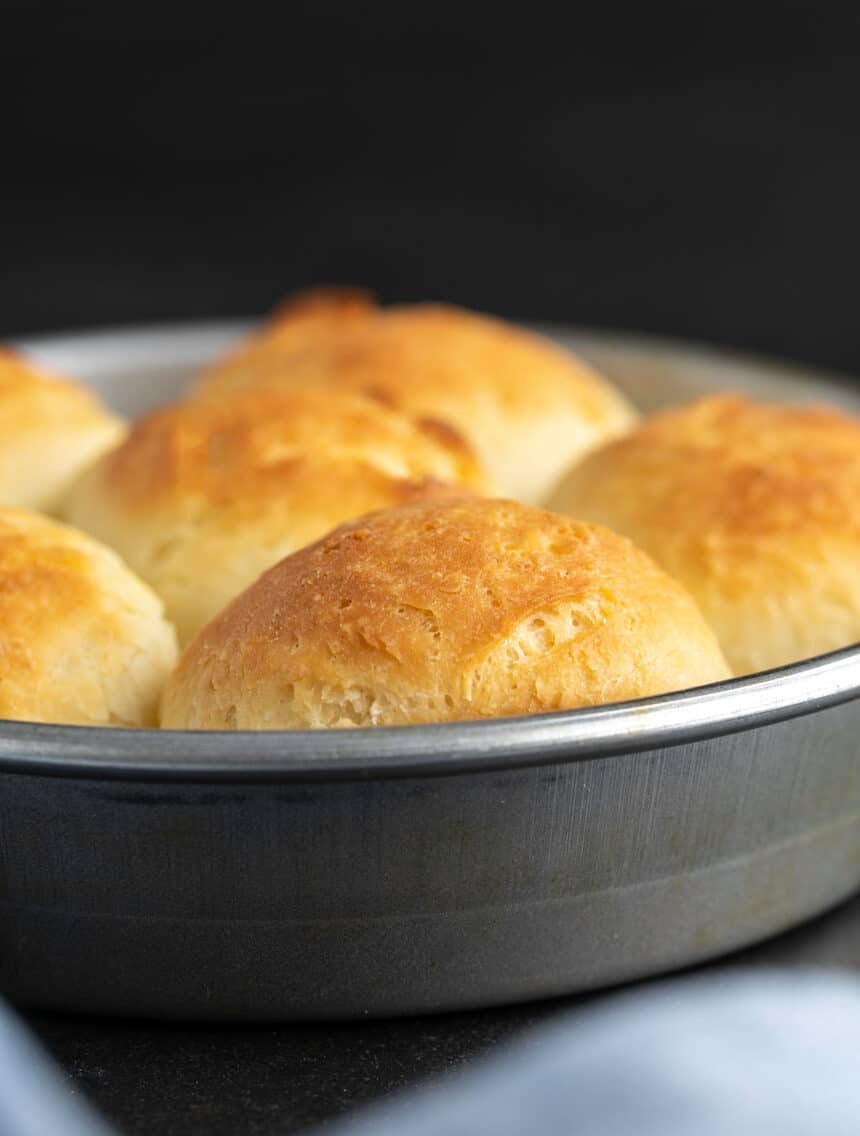
Gluten Free Dinner Rolls Recipe
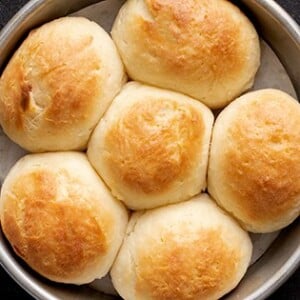
Ingredients
- 3 ¼ cups (455 g) all purpose gluten free flour blend, (See Recipe Notes)
- 3 ¼ teaspoons xanthan gum, omit if your blend already contains it
- ⅞ cup (105 g) tapioca starch/flour, plus more for sprinkling
- 4 teaspoons (12 g) instant yeast, See Recipe Notes
- ¼ cup (50 g) granulated sugar
- 1 teaspoon kosher salt
- 1 ⅝ cup (13 fluid ounces) warm milk (about 90°F)
- 8 tablespoons (112 g) unsalted butter, melted and cooled (plus more for brushing)
- 2 (50 g) egg whites, at room temperature
Instructions
Make the dough
- In the bowl of a stand mixer (See Recipe Notes), place the flour, xanthan gum, tapioca starch/flour, instant yeast, and granulated sugar, and whisk to combine well. Add the salt, and whisk again to combine.
- Add the milk, melted butter, and egg whites. Using the paddle attachment, beat vigorously. The mixture will come together in a clump and clear the sides of the bowl. Keep beating until it begins to look whipped, and sticks to the side of the mixing bowl again (about 6 minutes total).
- Transfer the mixture to a lightly oiled bucket or bowl with a very tight-fitting lid. The container should be large enough for the dough to nearly double (although it won’t double fully).
Chill the dough
- Refrigerate the dough for at least 30 minutes and up to 3 days in the refrigerator. Do not let the dough rest/rise for too long, or your rolls will rise much more irregularly after shaping.
- If your dough has been refrigerated for more than 1 hour, allow it to sit at room temperature until no longer very cold to the touch before working with it.
Shape the rolls
- Grease a quarter sheet pan or 2 8-inch round cake pans for baking, and set them aside. You will later decide if you’d like to crowd the rolls, and have them rise then bake touching, or have them separate.
- Flour a clean, dry work surface very lightly with tapioca starch. Divide the dough in half, then each half into 8 equal portions, for 16 pieces, each about 2 1/2 ounces in weight.
- Working with one piece of dough at a time, cup your fingers around the dough, keep the side of your palm on the surface, and move your hand in tight circles to coax the dough into a round.
- Place the shaped rounds of dough in your chosen baking pan(s) either touching (they will rise mostly up), or a bit more than 1-inch apart, taking care not to crowd them (the will rise up and out).
Let rise
- Cover the pan(s) with lightly greased plastic wrap, place in a warm, draft-free location, and allow to rise until about 150% of their original size (they won't quite double).
- This rise can take anywhere from 45 minutes to hours, depending upon the ambient temperature in your kitchen. Overproofing is not very likely, and can be detected when the surface of the rolls begins to look pockmarked.
- When the rolls are nearing the end of their rise, preheat your oven to 375°F. Once the rolls are properly risen, remove the plastic wrap from the pan(s), and brush generously on all exposed sides with melted butter.
Bake
- Bake until an instant read thermometer inserted into the center of each roll reads about 190°F.
- If there is any space between the rolls after they’ve risen, they will take around 20 minutes until fully baked.
- If the rolls are touching one another, lower the oven temperature to about 350°F at 18 minutes and continue to bake for about another 5 minutes or until the center reaches 190°F.
- Remove the pan from the oven, and with the rolls still in the hot pan, brush again with melted butter and serve warm.
Video
Notes
I recommend Better Batter’s original blend or my Nicole’s Best multipurpose blend (with 3 teaspoons added xanthan gum). King Arthur's gluten free bread flour can work but makes denser rolls, so consider adding 2 tablespoons more milk. Avoid Cup4Cup and Measure for Measure here—they won't produce the right texture. Bob’s Red Mill 1-to-1 isn't ideal, but in a pinch, it can work if you add 1½ teaspoons extra xanthan gum. To make your own blend using one of my “mock” recipes, please see the all purpose gluten free flour blends page. Using active dry yeast:
You can swap instant yeast for active dry yeast—just use 15 grams instead of 12 and proof it in some of the warm milk before adding. No stand mixer?
A food processor with the plastic blade works in a pinch. Don’t use a hand mixer or mix by hand; the dough needs vigorous mixing to whip up properly and create a smooth shaped roll.
Nutrition
Nutrition information is automatically calculated, so should only be used as an approximation.
Storing & freezing the rolls
Best when fresh
Like all yeast rolls, these are at their best the day they’re baked. But you can still store and reheat them with great results.
Room temperature
Store leftover rolls in a sealed container at room temperature for up to 2 days. To refresh before serving, sprinkle lightly with lukewarm water and warm in a 300°F toaster oven for about 5 minutes.
Freezer storage
Once cooled, place baked and cooled rolls in a freezer-safe zip-top bag and press out as much air as possible. Freeze for up to 3 months. Defrost at room temperature and reheat as above. For parbaking instructions, see the Expert Tips section above.
FAQs
If your rolls didn’t rise, it’s usually a problem with the yeast, hydration, temperature, or timing. Here are the most common causes:
Expired yeast – Test it by mixing with warm water and sugar. If it doesn’t foam in 10 minutes, it’s no longer active. Store opened jars of yeast in the refrigerator.
Too much flour/too little moisture – Overmeasuring flour or starch can reduce hydration and stall rising. The same can happen if the dough rises improperly covered, and loses moisture.
Temperature issues – Milk that’s too hot can kill yeast.
Timing – You simply didn't let them rise long enough. Yeast will reproduce in cooler environments, but will just take longer. Overproofing happens when dough rises too much, not for too long.
No—you still need the additional tapioca starch listed in the recipe. All gluten free blends include some tapioca, but this recipe relies on a larger amount to give the dough its flexibility and the rolls their soft, stretchy texture.
No—this dough won’t hold its shape that long after shaping. It’s best to refrigerate the dough before shaping, then bring it to room temperature and shape right before the second rise.
Not recommended—it's best to bake and freeze the rolls, or use the parbake method above.
Yes, but they won’t have the same pull-apart quality. Bake time may be slightly shorter.
Yes—just cut all ingredients in half. I do this all the time! Rise and bake times stay the same.
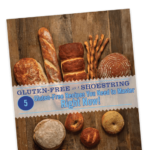
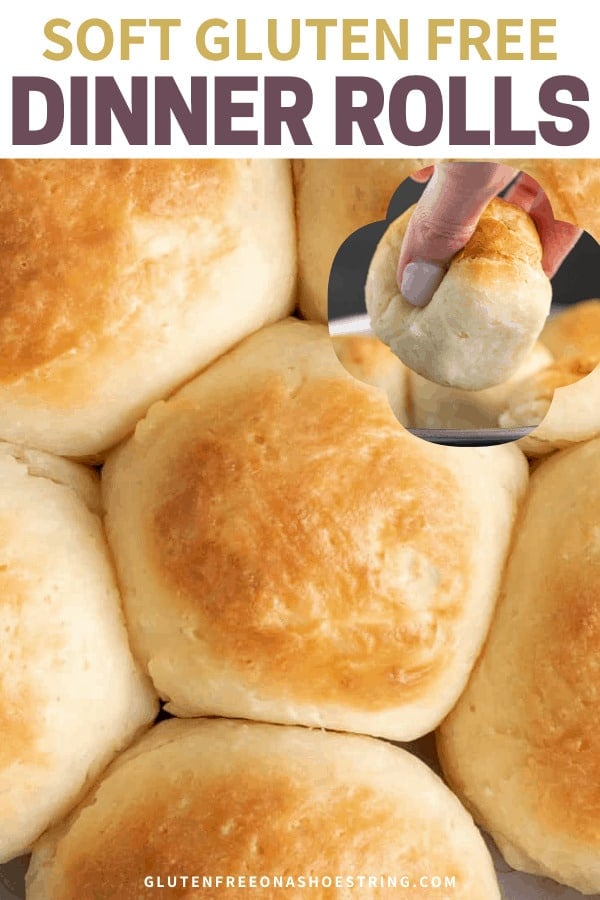
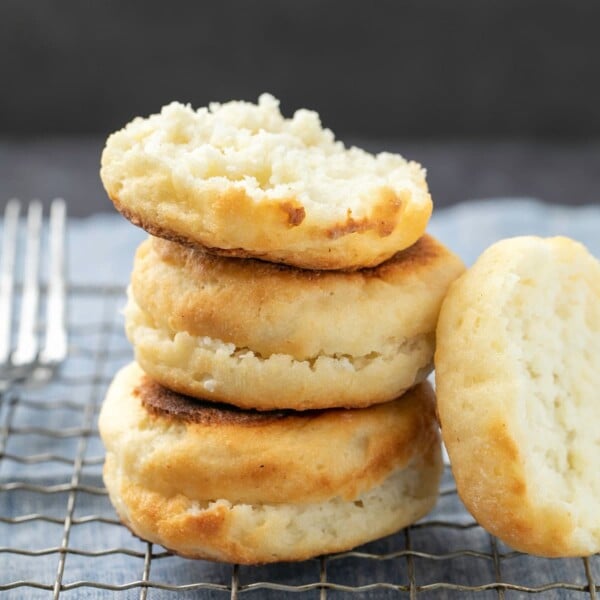
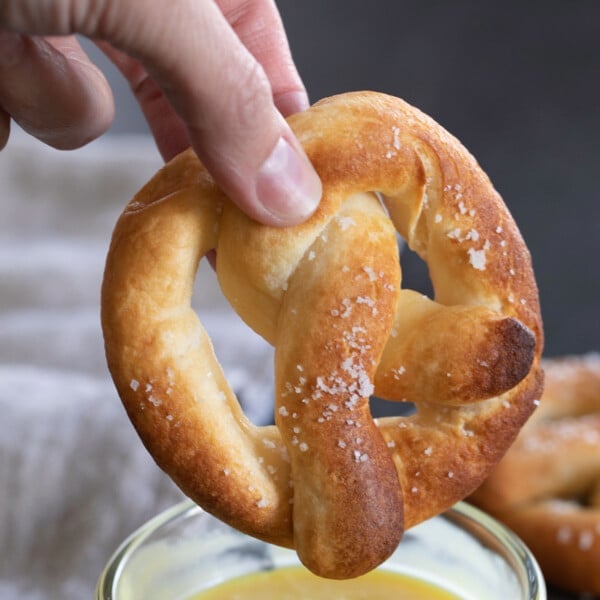
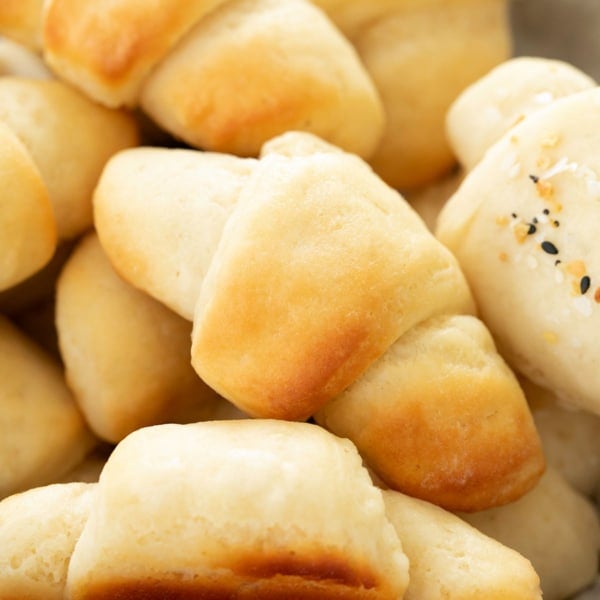
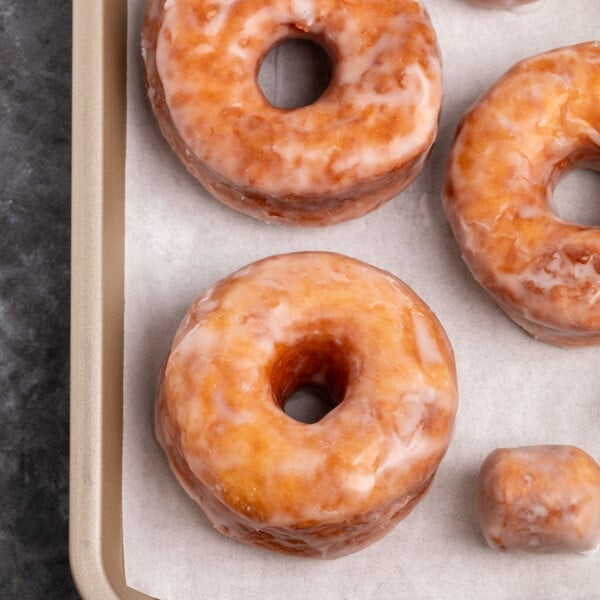









Hi, I just made these buns and they ended up being very dense. My yeast rose so well and they rose quite well in the bowl but once I made the buns, they just stayed the same size (I let them rise for 2 hours) without rising. Do you have any suggestions as to what I can change. I followed the recipe so any suggestions would be welcome! Thank you
Given what you described, it sounds like you likely incorporated too much flour into the rolls during shaping, which lowers the hydration ratio and makes it impossible for the yeast to continue to multiply. You really need to use a light touch and as little flour as possible in shaping. I hope that’s helpful!
Wonderful, rich yeasty flavor. Easily the best GF dinner rolls we’ve had. Thank you!
You’re so welcome, Don. So glad you loved them!
I made these rolls for Thanksgiving with Cup4Cup gluten free flour and they came out perfectly! I did knead the dough by hand for about 8 minutes (I did not have access to my mixer) and absolutely agree that this recipe needs to be done with a kitchen scale, as a measuring cup doesn’t necessarily equate to the correct amounts. I absolutely love this recipe and how easy it was to follow. Thank you!
Just made these – and they are the best gluten free rolls I have ever tried (and I have tried a lot!)
Thank you!
So happy to hear it, Tricia! Thanks for sharing your experience.
Happy Thanksgiving Nicole! I made these rolls for the fourth time tonight – and this time it was for a large crowd who all eat gluten :) They LOVED these rolls. I felt like I had the recipe down well enough to give it a go outside of our family and just had to report the success. I now have it down to where I know exactly when to start the rolls to time it perfectly to be done as the dinner is ready to serve. Thanks Nicole and so grateful for your recipes and the time you have committed to make them so perfect! Happy holidays to you and yours!
That’s so great to hear, Peggy, and thank you so much for the kind words and for sharing your experience. They sounds like they’re Peggy’s Rolls now. Like, “did Peggy bring her rolls?” I’m grateful that you appreciate the recipe’s precision and see that the rewards are worthwhile.
5 stars because your recipes are always amazing, so I know it’s not the recipe. But I am having the exact same problem right now with Cup4Cup. ALAS, not sure what to do with this gummy stuff, but on I plow! Next, time I will make some Better Batter.
I’m so sorry, Kate! It really is so frustrating and part of me feels like if there were only enough backlash, they might reintroduce the old formula at least as an alternative. Cup4Cup was never my first choice for yeast bread, but it sounds like now it’s just unworkable.
Unfortunately I didn’t read the reviews in time and I thought my flour would work. You must use the flour that is recommended in the recipe. I truly doubt any other flour works. I was using Bob’s Red Mill Gluten Free flour and experienced the same problems with wet dough. Maybe will try again next year, but will probably find a recipe that works with my flour.
I understand how frustrating it can be when a recipe doesn’t turn out as expected, Michaela. I try to be as clear as possible about the importance of the flour blend that you use both in the post and in the recipe card itself. Unfortunately, Bob’s Red Mill is one that I actively recommend against.
can this recipe be made into a loaf instead of rolls?
No, I’m afraid you can’t use this recipe to make a loaf, Julie. I do have quite a few recipes for gluten free bread in loaves, though. You can click that link for the category page or just use the search function.
This was a pretty darn good recipe for rolls and will meet my need for Thanksgiving dinner, and although isn’t a biscuit, does have a firm enough texture to be a good breakfast sandwich. That said, the process did not go as described in the recipe so I want to share with others what I did to overcome some of the challenges/unexpected results. As I made it (with a sticky wet dough), it also worked well as dough for fried-dough.
I followed the recipe strictly, using Cup4Cup so I omitted the Xanthan gum as instructed since it already has it. I measured every ingredient using a kitchen scale, including the eggs.
The dough was VERY wet. It was more like a cake or brownie batter than a dough. However, since I was confident I had measured everything accurately and followed the instructions, I proceeded to let the dough rise. It rose beautifully so then came the time to “knead the dough in your clean, dry hands, without adding any additional flour of any kind”. HA! This was laughable in my case because the moment I tried to use my clean dry hand to separate out my first round, I was so sticky and wet there was no way I was going to knead it or that my hands would be clean and dry again for the next round had I not improvised. Regardless of what I “should have done” up until that point or any suspicions you may have that I didn’t follow the directions and measurements (I did), I wasn’t going to waste the dough to try again. Since the instructions currently lack guidance on what to do if you get to the point I did with a wet sticky dough, this is what I did in case it helps others:
I basically skipped step 7. Instead I floured a baking mat with tapioca flour (not lightly by any means, because that didn’t work, but I tried to be careful about using the least amount I could get away with). I greased a spoon and, with the whole bowl of dough on the kitchen scale and zeroed out, I took spoonfools of about 2.5 oz and plopped them on the floured mat. With floured hands I gently tried to roll the dough over and loosely form a ball on the Mat. I could then pick it up and tossed it gently in my hand to form the ball and pinch any creases as needed. It was NOT firm and was quite soft, so I was very gentle, then placed in the pan.
The second rise worked well, but it was definitely done in about 35 minutes, and the batch baked beautifully. I wanted to parbake half, but didn’t have enough space to separate them enough without them touching post-rise, so I fully baked them all. One deflated when I tried to move it, but that gave me an idea to try it as fried dough and it actually worked really well!
The author is correct that they start to lose quality after sitting around, but since I need rolls for thanksgiving and will definitely not have the ability to bake rolls in perfect timing with thanksgiving dinner, I’m going to try to freeze them and hope they will warm well enough for dinner.
Note for author: it would be really helpful if you include some troubleshoot tips in the recipe notes for when it doesn’t come together as intended. I heard your repeated advice for folks to very carefully measure the ingredients, but when a person tries and still gets an unexpected result it would be helpful to know what to do to correct instead of just hoping to get it right next time.
Thanks for sharing your experience. Unfortunately, Jenny, if you purchased Cup4Cup recently, they have changed the formula and it simply doesn’t work the same any longer, which is very upsetting since it was one of my top recommendations. I’m afraid there’s nothing I can do about that. You didn’t mention whether you added additional tapioca starch as a separate ingredient, and if you did not, your dough would likely behave similarly to what you described.
Yes, I did add the tapioca starch as described. That’s a bummer that they changed the formula.
Do you know approximately when they changed the formula? I want to make sure I am careful about using it in recipes that are particular like this one if they were written to account for the cup4cup pre-change.
It was quite recent, I’m afraid, Jenny. Maybe in the last couple months? It’s such a bummer because it had come down in price so much, and was a great grocery store option. I keep hoping they’ll reintroduce the old formula like they did with Classic Coke!
I am JUST making these as a test for Thanksgiving. And I am experiencing the same thing with cup 4 cup. The dough has not pulled away from the sides, despite beating for more than 6 minutes, so I thought I’d check to see if there were any trouble shooting suggestions. I don’t know if I should try beating in a bit more tapioca, or just go with the wet sticky dough. I think I’m going to try adding a couple tablespoons of tapioca.
It was never my top recommendation for yeast bread, but it did work. Now, I can see that it’s really struggling, and I’m afraid I don’t know what to suggest, Katie, as you can see about the reformulation much for the worse.
This is what test runs are for! 😊 I did add 2 TB tapioca. Didn’t change things too much, but I was afraid to add more. So I am about to shape them now and I’ll see what happens. I guess I need to run to the store and get the ingredients to make your mock version before Thursday.
I’m so sorry, Katie. Cup4Cup was never my recommendation for yeast bread, but it sounds like now it just doesn’t work—especially for something shaped. Such a shame. Thank you for your understanding and grace. I wish I could help more!
It would be helpful to add the directions for using a bread machine to make the dough. I hope it works. I also used cup4cup and i halved the recipe just in case it didnt.
I’m afraid I recommend using a bread machine to make this recipe, Kimberly, which is why I don’t have bread machine directions.
For what it’s worth, I just heated up the last roll I baked four days ago, microwaved it for 30 seconds, and it was pretty darn good. Although my experience baking the first time around didn’t go as planned because of the change in Cup4Cup, I’m overall pretty satisfied and upgrade the rating to a 5.
I have Pamela’s bread flour it has xanthan and tapioca flout in it. Will it work for these rolls?
I’m afraid I don’t have any experience with their bread flour, Melodie, but I have not had luck using Pamela’s other blends in my recipes. Either way, almost every gluten free flour blend already has some tapioca starch in it. The tapioca starch called for in this recipe is an additional ingredient, regardless of what your blend already has.